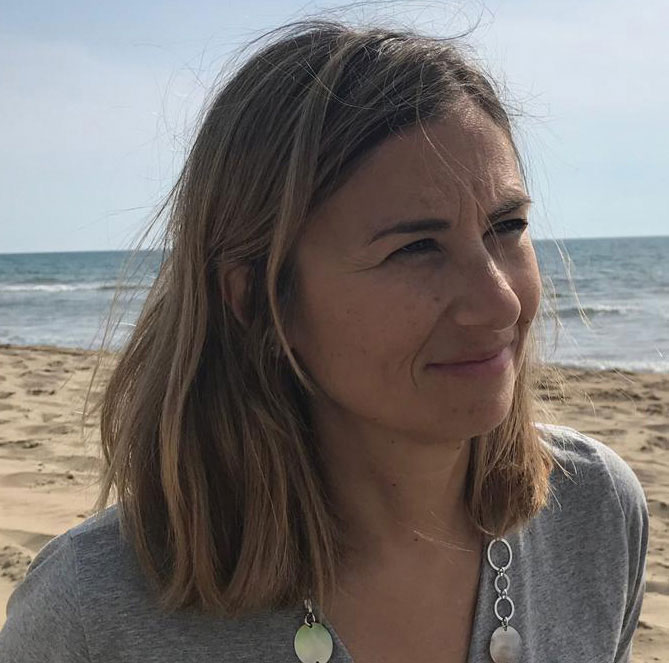Honors and Fellowships (societies, boards,…)
2019-present: Review editor in Frontiers in Molecular Neuroscience.
2018-present: Reviewer for funding agencies: Thierry Latran Foundation (France), MRC (Cambrigde, UK).
2007: Post-Doc Fellowship by “Attività di Ricerca Biomedica-Santa Lucia Foundation-2007”. Title: “Physiopatological aspects of P2 receptor interactions in neuronal models.”
2006: Post-Doc Fellowship by “Attività di Ricerca Biomedica-Santa Lucia Foundation-2006”. Title: “Molecular interactions among metabotropic receptors in neuronal models.”
2005: Post-Doc Fellowship by Tor Vergata University of Rome (MIUR-COFIN 2004).
2002-2004: Post-Doc Fellowship by Tor Vergata University of Rome (MIUR-COFIN 2001). Title: “Study of purinerigic P2 receptors in physiological and pathological conditions.”
1998: Honorary Research fellowship by Royal Free Hospital, Autonomic Neuroscience Institute, London, UK
Grants:
-2019-2021: AriSLA, SPLICEALS Title: “Dissecting the functional interaction between FUS and hnRNP A2/B1 in the pathogenesis of ALS”
-2018-2019: University of Rome Tor Vergata, Grant “Mission: Sustainability”, Title: “RAAFT – Study of the role of ATM e c-Abl in FrontoTemporal Dementia”
-2017: Finanziamento delle attività base di ricerca (Grant for basic research activities), MIUR
-2016: UCSC Linea D.1 2016 #70201470, Title: “Role of lipid droplets in neuroinflammation in a murine model of ALS”
-2015: UCSC Linea D.1 2015 #70201344, Title: “Analysis of RAGE trafficking in astrocytes derived from ALS mouse models”
-2014: UCSC Linea D.1 2014 # 70201184, Title: “Inhibition of Neuroinflammation in ALS”
-2013: UCSC Linea D.1 2013 # 70201024, Title: “Role of the protein S100B in ALS”
-2010-2014: AriSLA # RBA50/2009 PRALS, Title: “P2X7 receptor in ALS”
-2010-2012: Thierry Latran Foundation, Title: “P2X7 receptor in ALS”
Research interests:
My research activity has always been focused on the physiology and pathology of the nervous system. During the last ten years I’ve been investigating cellular alterations and dysregulated molecular pathways leading to amyotrophic lateral sclerosis (ALS), analyzing the main cell type targeted by the disease, motor neurons, and the essential cell compartment involved in the progression of the disease, represented by glia.
Our current lines of research are focused on the following themes:
– A large body of evidence indicates that the loss of motor neurons in ALS is caused by defects in the regulation of RNA metabolism. The main goal of this project is to identify molecules and mechanisms mainly involved in this process, and in particular to understand how the RNA-binding protein FUS, implicated in ALS, affects the splicing of molecules involved in RNA maturation and how these molecules impact on ALS-relevant phenotypes.
– Microglia and astrocytes are main contributors to ALS, since their abnormal activity, observed during the disease, seems to be detrimental to motor neurons. Therefore, an approach to limit motor neuron demise is to understand and control the dysregulated pathways in glia. One of the main features of neuroinflammation is the massive migration of glia towards the site of injury, and we propose that limiting this phenomenon could be beneficial to the disease. We have identified a molecule (S100A4-metastasin) involved in cell migration, which is highly upregulated in affected tissues. We aim to inhibit its expression (through genetic and pharmacological tools) in specific cell types and in animal models of ALS, to test whether this approach can limit several features of the disease.
Publications (last ten years, max 15) :
1: Michetti F, D’Ambrosi N, Toesca A, Puglisi MA, Serrano A, Marchese E, Corvino V, Geloso MC. The S100B story: From biomarker to active factor in neural injury. J Neurochem. 2018 Aug 24. doi: 10.1111/jnc.14574.
2: Salvatori I, Ferri A, Scaricamazza S, Giovannelli I, Serrano A, Rossi S, D’Ambrosi N, Cozzolino M, Giulio AD, Moreno S, Valle C, Carrì MT. Differential toxicity of TAR DNA-binding protein 43 isoforms depends on their submitochondrial localization in neuronal cells. J Neurochem. 2018 May 20. doi: 10.1111/jnc.14465.
3: D’Ambrosi N, Cozzolino M, Carrì MT. Neuroinflammation in Amyotrophic Lateral Sclerosis: Role of Redox (dys)Regulation. Antioxid Redox Signal. 2018 Jul 1;29(1):15-36. doi: 10.1089/ars.2017.7271.
4: Geloso MC, Corvino V, Marchese E, Serrano A, Michetti F, D’Ambrosi N. The Dual Role of Microglia in ALS: Mechanisms and Therapeutic Approaches. Front Aging Neurosci. 2017 Jul 25;9:242. doi: 10.3389/fnagi.2017.00242
5: Serrano A, Donno C, Giannetti S, Perić M, Andjus P, D’Ambrosi N*, Michetti F. The Astrocytic S100B Protein with Its Receptor RAGE Is Aberrantly Expressed in SOD1(G93A) Models, and Its Inhibition Decreases the Expression of Proinflammatory Genes. Mediators Inflamm. 2017;2017:1626204. doi: 10.1155/2017/1626204. * co-last author
6: Carrì MT, D’Ambrosi N, Cozzolino M. Pathways to mitochondrial dysfunction in ALS pathogenesis. Biochem Biophys Res Commun. 2017 Feb 19;483(4):1187-1193. doi: 10.1016/j.bbrc.2016.07.055.
7: D’Ambrosi N, Rossi S, Gerbino V, Cozzolino M. Rac1 at the crossroad of actin dynamics and neuroinflammation in Amyotrophic Lateral Sclerosis. Front Cell Neurosci. 2014 Sep 8;8:279. doi: 10.3389/fncel.2014.00279.
8: Apolloni S, Amadio S, Parisi C, Matteucci A, Potenza RL, Armida M, Popoli P, D’Ambrosi N*, Volonté C. Spinal cord pathology is ameliorated by P2X7 antagonism in a SOD1-mutant mouse model of amyotrophic lateral sclerosis. Dis Model Mech. 2014 Sep;7(9):1101-9. doi: 10.1242/dmm.017038. * co-last author
9: Parisi C, Arisi I, D’Ambrosi N, Storti AE, Brandi R, D’Onofrio M, Volonté C. Dysregulated microRNAs in amyotrophic lateral sclerosis microglia modulate genes linked to neuroinflammation. Cell Death Dis. 2013 Dec 12;4:e959. doi: 10.1038/cddis.2013.491.
10: Apolloni S, Amadio S, Montilli C, Volonté C, D’Ambrosi N. Ablation of P2X7 receptor exacerbates gliosis and motoneuron death in the SOD1-G93A mouse model of amyotrophic lateral sclerosis. Hum Mol Genet. 10.1093/hmg/ddt259.
11: Apolloni S, Parisi C, Pesaresi MG, Rossi S, Carrì MT, Cozzolino M, Volonté C, D’Ambrosi N. The NADPH oxidase pathway is dysregulated by the P2X7 receptor in the SOD1-G93A microglia model of amyotrophic lateral sclerosis. J Immunol. 2013 May 15;190(10):5187-95. doi: 10.4049/jimmunol.1203262.
12: Volonté C, Apolloni S, Carrì MT, D’Ambrosi N. ALS: focus on purinergic signalling. Pharmacol Ther. 2011 Oct;132(1):111-22. doi: 10.1016/j.pharmthera.
13: Amadio S, Apolloni S, D’Ambrosi N, Volonté C. Purinergic signalling at the plasma membrane: a multipurpose and multidirectional mode to deal with amyotrophic lateral sclerosis and multiple sclerosis. J Neurochem. 2011 Mar;116(5):796-805. doi: 10.1111/j.1471-4159.2010.07025.x
14: Apolloni S, Finocchi P, D’Agnano I, Alloisio S, Nobile M, D’Ambrosi N, Volonté C. UDP exerts cytostatic and cytotoxic actions in human neuroblastoma SH-SY5Y cells over-expressing P2Y6 receptor. Neurochem Int. 2010 Apr;56(5):670-8. doi: 10.1016/j.neuint.2010.02.003.
15: D’Ambrosi N, Finocchi P, Apolloni S, Cozzolino M, Ferri A, Padovano V, Pietrini G, Carrì MT, Volonté C. The proinflammatory action of microglial P2 receptors is enhanced in SOD1 models for amyotrophic lateral sclerosis. J Immunol. 2009 Oct 1;183(7):4648-56. doi: 10.4049/jimmunol.0901212.
Education and training:
-2016-present Assistant Professor (RTDB) in Biochemistry, Department of Biology, Tor Vergata University of Rome
-2013-2016: Assistant Professor (RTDA) in Cell Biology at the Faculty of Medicine, Catholic University of the Sacred Heart, Rome
-2008-2013: Senior Researcher at Santa Lucia Foundation, Rome, Italy
-2003-2007: Post-doc Researcher at Santa Lucia Foundation, Rome, Italy
-1998-2002: Ph. D. in Neuroscience, Faculty of Medicine and Surgery, University of Rome Tor Vergata
-1998: Junior fellow at Royal Free Hospital, Autonomic Neuroscience Institute, London, UK.
-1998: Master’s Degree in Biological Sciences, University of Rome “La Sapienza”


